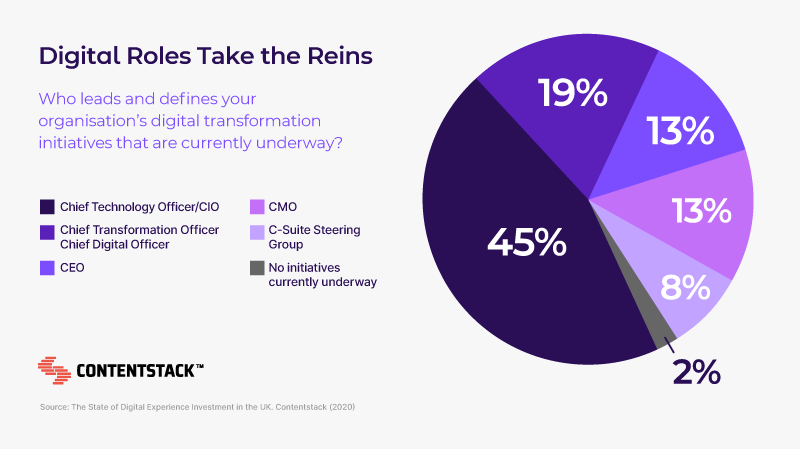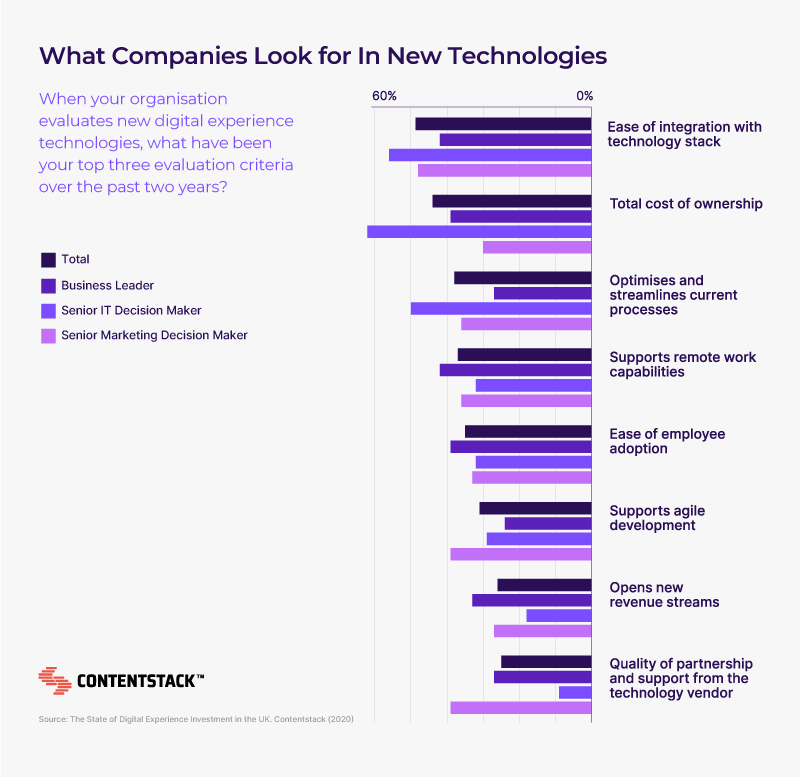Survey: The Pains and Priorities of Digital Experience for IT Leaders in 2020

Share

We recently conducted a survey of 100 business, technology, and marketing leaders at UK enterprises to learn more about how well current digital experience investment aligns with digital transformation ambitions. Overall, we found out that there is a lot of room for improvement. Only 27% of respondents said their current tools were adequate to meet their ambitions over the next 18 months. Furthermore, companies are wasting a quarter of their digital experience budget on capabilities they don’t use.
Nearly all (98%) of these organizations have some sort of digital transformation project underway, and technology executives are at the helm of most of these efforts.

These survey results give valuable insight into the pain points these digital leaders are experiencing with their current investment, how they plan on moving forward, and the slight differences in their transformation ambitions compared to their business and marketing counterparts.
The Role of IT is Getting Wider
As digital expands its reach across the enterprise, it blurs the roles and responsibilities within the C-suite. IT leaders see an increase in project requests — a 40% increase in 2020 according to a MuleSoft report published at the start of the year — and an increase in the work required to get the company on board with new changes.
This year has made it clear just how critical digital business is. IT has seen an increase in focus and funding due to the pandemic, with 38% of IT decision makers saying it has helped improve the understanding of the department and 30% saying they now have more control over business decisions.
This increased authority, combined with their wide-angle view of the company’s digital architecture, sets the stage for IT leaders to make significant shifts in an organization’s digital maturity.
Today’s Investment Pains
Technology, business, and marketing leaders agree about the current state of their digital experience investment. All three groups report that a quarter of their investment is inadequate for today’s ambitions, and roughly half of the features and capabilities in that investment go unused.
However, there are differences in opinions on future technology choices. Over the next 18 months, 52% of business leaders expect to invest in new technologies compared to 36% of IT leaders. In the same time period, marketing and business leaders expect current investment to become more inadequate while IT leaders don’t expect further decay.

This could be attributed to IT leaders having a better overview of the current toolkit. There may be tools already purchased, not yet implemented, that are capable of meeting future needs. With 74% of IT leaders listing “lack of integrations with other technologies” as a top factor contributing to technology inadequacy, they may be aware of upcoming integration plans that will make specific tools more usable. So while some investments will decay, other investments will become more adequate over time.
On the other hand, the difference could indicate that business and marketing leaders hear more about the capability performance from the user’s perspective. The backend of a solution might be smoothly implemented, and theoretically, it should be able to do what you want. Still, if users find it frustrating, it won’t be seen as an adequate technology. Both groups were more likely than their IT counterpart to say that the high cost of implementation and low employee adoption were barriers responsible for unused digital experience capabilities.
IT leaders will need to address departmental barriers and differences in expectations to ensure future technologies have the best chance of success.
New Technology Priorities
When asked about their top three evaluation criteria for new technologies, IT leaders were most likely to say the total cost of ownership (62%), ease of integration (56%), and optimizing current processes (50%). They were least likely to be looking to new technologies to open new revenue streams. With half of CTOs stating that part of their role is dedicated to the modernization of core technology infrastructure, it makes sense that the top priorities would revolve around fine-tuning business processes, budgets, and the backend.

How 2020 has Shifted Priorities
It’s estimated that the impact of COVID-19 has accelerated companies’ digital communication strategies by a global average of 6 years. An IBM survey found that 66% of executives have completed initiatives this year that previously encountered resistance. Traditional and perceived barriers like technology immaturity and employee opposition to change have fallen away.
When asked how COVID-19 has impacted their technology evaluation criteria, each criterion was more important by at least half of technology leaders. Remote work support and ease of employee adoption saw the most impact, with 83% and 71% saying they were more critical, respectively.
IT leaders have had to take on the monumental task of figuring out how to keep business running with a suddenly remote workforce, so it’s no surprise that their top priorities focus on ensuring tools are usable. With over half of employees wanting to continue working remotely after the pandemic, the technology decisions an organization makes now are laying the foundation for the long-term.
Steps to a Successful IT-Led Digital Transformation
In a recent ebook about modern enterprise architecture, we interviewed digital directors who are currently leading their organizations through major transformation efforts. They shared some of the key lessons they’ve learned along the way to company-wide change.
Align the Brand Early
When Tom Morgan, Director of Digital at The Spectator, was tasked with modernizing the British media company’s architecture, he said the first step was to understand what the 200-year-old brand meant to their readers.
“In order to have a chance of changing people’s perceptions around technology, I really needed to be able to speak the brand language. That was a case of spending immersive time with our product, but also spending immersive time with our customers. Above all the other change mechanisms we did, all the prototypes and all the bulldozing, that was probably the most powerful one. It means that now, when I sit with other stakeholders and talk about decisions from a technology point of view, I can talk with a position of authority about what that means to our readers and what that means to our customers, but also what it means to our legacy and our institution.”
Departmental Projects to Multidisciplinary Products
Whereas projects have clear end dates and focus on concrete deliverables, products have evolving roadmaps and focus on delivering functionality and measurable value add. This sets up a space for cross-departmental teams to collaborate on the full product lifecycle — planning, design, implementation, launch, value measurement, improvement, maintenance, and retirement.
Approaching transformation with a cross-section of departments helps each stage go smoother, says the Director of Digital at an iconic British luxury fashion house. “There will always be mini compromises along the way, but you can have a lot of unity from the very beginning in the choices you make. That sets you up well for the phase where you deliver.”
New Types of Vendor Partnerships
While IT respondents were not likely to place importance on vendor support, 39% of business leaders felt it was a top reason current investment will become inadequate. Marketing leaders ranked it as the second most important evaluation criteria for new technology.
Marketing and business teams who are eager to employ modern software capabilities are looking to partner with vendors to pilot new types of digital experiences. While IT departments may have a more realistic view of how mature the architecture is and feel the company is not yet ready for these initiatives.
However, for enterprises that are ready to modernize their architecture, a vendor relationship is fruitful. In interviews about their move to MACH architecture (Microservices, API-first, Cloud-native, Headless), digital leaders discussed this partnership’s importance.
“We’re going to be the first UK publisher to be doing headless at this scale. You can’t do that without an understanding from your solution partner that it’s more than just a software-as-service relationship. It’s a deeper part of the journey.” -Tom Morgan, Director of Digital, The Spectator
Strong Collaboration For A Smooth Journey
Companies that aim to be digital leaders will have to take some paths that don’t have clear roadmaps.
When companies stall in their digital progress, the cause is more likely to be misaligned culture (18%) or insufficient commitment across the organization (14%) than significant disruptions to the market (6%), according to a study by McKinsey & Company. The most commonly cited reason for those who avoided digital derailment was “strong alignment and commitment across the organization.”
Clear communication among the C-suite, departments, and external vendors can match priorities with possibilities and create the smoothest journey to digital transformation.
See the full results of the UK enterprise leader survey: The State of Digital Experience Investment in the United Kingdom
Learn more about how Digital Directors are modernizing business: Break the Replatforming Cycle with MACH Enterprise Architecture



